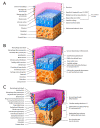Knee Osteoarthritis: A Review of Pathogenesis and State-Of-The-Art Non-Operative Therapeutic Considerations
- PMID: 32722615
- PMCID: PMC7464436
- DOI: 10.3390/genes11080854
Knee Osteoarthritis: A Review of Pathogenesis and State-Of-The-Art Non-Operative Therapeutic Considerations
Abstract
Being the most common musculoskeletal progressive condition, osteoarthritis is an interesting target for research. It is estimated that the prevalence of knee osteoarthritis (OA) among adults 60 years of age or older is approximately 10% in men and 13% in women, making knee OA one of the leading causes of disability in elderly population. Today, we know that osteoarthritis is not a disease characterized by loss of cartilage due to mechanical loading only, but a condition that affects all of the tissues in the joint, causing detectable changes in tissue architecture, its metabolism and function. All of these changes are mediated by a complex and not yet fully researched interplay of proinflammatory and anti-inflammatory cytokines, chemokines, growth factors and adipokines, all of which can be measured in the serum, synovium and histological samples, potentially serving as biomarkers of disease stage and progression. Another key aspect of disease progression is the epigenome that regulates all the genetic expression through DNA methylation, histone modifications, and mRNA interference. A lot of work has been put into developing non-surgical treatment options to slow down the natural course of osteoarthritis to postpone, or maybe even replace extensive surgeries such as total knee arthroplasty. At the moment, biological treatments such as platelet-rich plasma, bone marrow mesenchymal stem cells and autologous microfragmented adipose tissue containing stromal vascular fraction are ordinarily used. Furthermore, the latter two mentioned cell-based treatment options seem to be the only methods so far that increase the quality of cartilage in osteoarthritis patients. Yet, in the future, gene therapy could potentially become an option for orthopedic patients. In the following review, we summarized all of the latest and most important research in basic sciences, pathogenesis, and non-operative treatment.
Keywords: cytokines; epigenomics; genetic therapy; knee osteoarthritis; mesenchymal stem cells; phenotype; platelet-rich plasma.
Conflict of interest statement
The authors declare no conflict of interest.
Figures


References
Publication types
MeSH terms
Substances
LinkOut - more resources
Full Text Sources
Other Literature Sources
Medical

